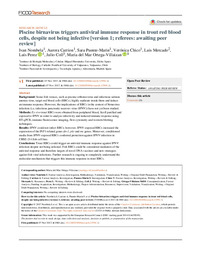Please use this identifier to cite or link to this item:
https://hdl.handle.net/11000/34446Full metadata record
| DC Field | Value | Language |
|---|---|---|
| dc.contributor.author | Nombela, Ivan | - |
| dc.contributor.author | Carrion, Aurora | - |
| dc.contributor.author | Puente Marin, Sara | - |
| dc.contributor.author | CHICO GRAS, VERONICA | - |
| dc.contributor.author | Mercado, Luis | - |
| dc.contributor.author | Perez, Luis | - |
| dc.contributor.author | coll, julio | - |
| dc.contributor.author | Ortega-Villaizan, Maria del Mar | - |
| dc.date.accessioned | 2025-01-14T12:52:30Z | - |
| dc.date.available | 2025-01-14T12:52:30Z | - |
| dc.date.created | 2017-11 | - |
| dc.identifier.citation | F1000Research, 2017 | es_ES |
| dc.identifier.issn | 2046-1402 | - |
| dc.identifier.uri | https://hdl.handle.net/11000/34446 | - |
| dc.description.abstract | Some fish viruses, such as piscine orthoreovirus and infectious salmon Background: anemia virus, target red blood cells (RBCs), highly replicate inside them and induce an immune response. However, the implications of RBCs in the context of birnavirus infection (i.e, infectious pancreatic necrosis virus (IPNV)) have not yet been studied. trout RBCs were obtained from peripheral blood, ficoll purified and Methods:Ex vivo exposed to IPNV in order to analyze infectivity and induced immune response using RT-qPCR, immune fluorescence imaging, flow cytometry and western-blotting techniques. IPNV could not infect RBCs; however, IPNV-exposed RBCs increased the Results: expression of the INF1-related genes and genes. Moreover, conditioned ifn-1, pkr mx media from IPNV-exposed RBCs conferred protection against IPNV infection in CHSE-214 fish cell line. Trout RBCs could trigger an antiviral immune response against IPNV Conclusions: infection despite not being infected. Fish RBCs could be considered mediators of the antiviral response and therefore targets of novel DNA vaccines and new strategies against fish viral infections. Further research is ongoing to completely understand the molecular mechanism that triggers this immune response in trout RBCs. | es_ES |
| dc.format | application/pdf | es_ES |
| dc.format.extent | 12 | es_ES |
| dc.language.iso | eng | es_ES |
| dc.publisher | Taylor y Francis | es_ES |
| dc.rights | info:eu-repo/semantics/openAccess | es_ES |
| dc.rights | Attribution-NonCommercial-NoDerivatives 4.0 Internacional | * |
| dc.rights.uri | http://creativecommons.org/licenses/by-nc-nd/4.0/ | * |
| dc.subject.other | CDU::6 - Ciencias aplicadas::60 - Cuestiones generales de las ciencias aplicadas | es_ES |
| dc.title | Piscine birnavirus triggers antiviral immune response in trout red blood cells, despite not being infective[version 1; referees: awaiting peer review] | es_ES |
| dc.type | info:eu-repo/semantics/article | es_ES |
| dc.contributor.institute | Institutos de la UMH::Instituto de Investigación, Desarrollo e Innovación en Biotecnología Sanitaria de Elche | es_ES |
| dc.relation.publisherversion | https://doi.org/10.12688/f1000research.12994.2 | es_ES |

View/Open:
fae64a36e17465c01c5fa3ad4138a0f55321.pdf
974,52 kB
Adobe PDF
Share:
.png)
